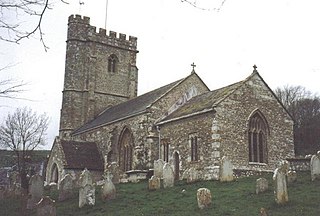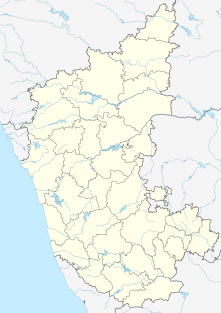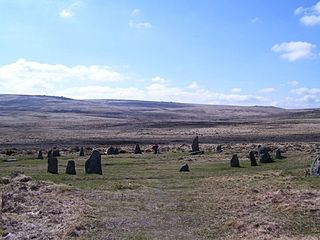
Litton Cheney is a village and civil parish in the county of Dorset in south-west England. It lies within the West Dorset administrative district, 9 miles (14 km) west of the county town Dorchester. It is sited beneath chalk hills in the valley of the small River Bride. In the 2011 census the parish had a population of 359.

The stone circle at Castlerigg is situated near Keswick in Cumbria, North West England. One of around 1,300 stone circles in the British Isles and Brittany, it was constructed as a part of a megalithic tradition that lasted from 3,300 to 900 BC, during the Late Neolithic and Early Bronze Ages.

Khorramabadpronunciation (help·info) is a city and capital of Lorestan Province, Iran. At the time of the 2006 census, its population was 328,544, in 75,945 families. Khorramabad is situated in the Zagros Mountains. Khorramabad Airport is 3 km south of the city proper.

The Senegambian stone circles lie in The Gambia north of Janjanbureh and in central Senegal.

Tan Hill is a hill which lies just to the north of the village of Allington in the parish of All Cannings, Wiltshire, England.

Ramateertham is a village panchayat in Nellimarla mandal of Vizianagaram district in Andhra Pradesh in India.It is about 12 km from Vizianagaram city. It is a famous Pilgrimage and also Ancient Historical Site since 3rd Century BCE There is a post office at Ramateertham. The PIN code is 535 218.

Stoplesteinan is a stone circle in the town of Egersund, Rogaland in Norway.

Rujm el-Hiri is an ancient megalithic monument consisting of concentric circles of stone with a tumulus at center. It is located in the Israeli-occupied portion of the Golan Heights, some 16 kilometres (9.9 mi) east of the coast of the Sea of Galilee, in the middle of a large plateau covered with hundreds of dolmens.

Knocknakilla is the site of a megalithic complex situated between Macroom and Millstreet, in County Cork, Ireland. It is set in blanket peatland on the north-west upper slopes of Musherabeg mountain and is thought to be 3500 years old.

Concentrations of megaliths, dolmens and stone labyrinths dating between the end of the 4th millennium and the beginning of the 2nd millennium B.C. have been found throughout the Caucasus Mountains, including Abkhazia. Most of them are represented by rectangular structures made of stone slabs or cut in rocks with holes in their facade. These dolmens cover the Western Caucasus on both sides of the mountain ridge, in an area of approximately 12,000 square kilometres of Russia and Abkhazia.

Bettadapura is a town located in Mysore district, in the Indian state of Karnataka. The name is derived from two Kannada words, "Betta" and "pura". Betta means "hill" and pura means "town".

Gray Hill is a hill immediately to the north of the village of Llanvair Discoed, Monmouthshire, south east Wales. Its summit is at 273 metres (896 ft).

The Whetstones are, or were, a stone circle beneath Corndon Hill in the parish of Church Stoke, Montgomeryshire, Wales, near the border with Shropshire, England. They lie immediately to the west of the village of White Grit and close to Priestweston. The site is also a short distance from the better-known Hoarstones and Mitchell's Fold circles.

ScorhillStone Circle is now the commonly known name for Gidleigh Stone Circle or Steep Hill Stone Circle, one of Devon's biggest and most intact stone circles, situated on Gidleigh Common near the village of Gidleigh in the north east of Dartmoor, in the United Kingdom. It is an English Heritage scheduled monument and has been described as Devon's finest stone circle.

The dolmen de Bagneux is a megalith located in Saumur, France. It is one of the largest dolmen in France and in Europe.

The Nine Stones, also known as the Devil's Nine Stones, the Nine Ladies, or Lady Williams and her Dog, is a stone circle located near to the village of Winterbourne Abbas in the southwestern English county of Dorset. Archaeologists believe that it was likely erected during the Bronze Age.

The Nedumala Caves are in Piralimattam. They are located on the border of Idukki district and Ernakulam District in Kerala state, India. Piralimattom Nedumala hills is a prehistoric site. Caves well carved on granite rock and stone shelter are here. According to Dr. P. Rajendran, an archaeologist and UGC Research Scientist, caves are points towards its chronology to the Neolithic period of around 4000 BC.

Withypool Stone Circle, also known as Withypool Hill Stone Circle, is a stone circle located on the Exmoor moorland, near the village of Withypool in the southwestern English county of Somerset. The ring is part of a tradition of stone circle construction that spread throughout much of Britain, Ireland, and Brittany during the Late Neolithic and Early Bronze Age, over a period between 3300 and 900 BCE. The purpose of such monuments is unknown, although archaeologists speculate that the stones represented supernatural entities for the circle's builders.

Podutik is a former settlement in central Slovenia in the northwest part of the capital Ljubljana. It belongs to the Dravlje District of the City Municipality of Ljubljana. It was part of the traditional region of Upper Carniola and is now included with the rest of the municipality in the Central Slovenia Statistical Region.



















